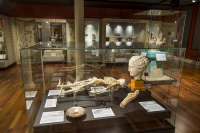
Beyond the Grave: Death in Ancient Times
Teece Museum of Antiquities
Warren Feeney
Like a survey exhibition of Rembrandt’s self-portraits, the Teece Museum of Antiquities,’ Beyond the Grave: Death in Ancient Times is pervaded by an awareness of the brevity of our lives and inevitability of death.
The exhibition includes objects and artefacts from the University of Canterbury’s Logie Collection and selected works from public and private collections. It is a meticulous and considered show, informative and impressive in its choice of objects for display. Memorial busts, carved relief-panels, amphora, armour and manuscripts, collectively make for an experience, plentiful and surprising in its ability to make “ancient times” seem far from ancient.
A particular favourite is a large Canosan Askos (a late 3rd/early 2nd century BC funerary vase), its surfaces inhabited by Greek figures and mythological creatures: Medusa’s head guarding the ashes of the deceased; two tritons (mermen – part horse and part fish), three mourning women with hands raised in the air in grief and two sea-horses. 21st century minds and eyes should be forgiven for reading the subjects of this funerary vase as an amalgam of subjective scenarios and ideologies. Undoubtedly, contemporary ceramicists like Grayson Perry and Paul Maysek come to mind.
Beyond the Grave: Death in Ancient Times is disarming in its ability to establish such immediate and rewarding relationship with the gallery visitor. There are many interesting and - on first encounter - puzzling surprises. For example; the mid 2nd century sarcophagus relief with cherub-like figures (erotes or ‘cupids) clustered around a portrait of the deceased. It is a confronting reminder of the paradox of the consciousness of life and accompanying awareness of death as fundamental to the human condition. It’s an idea similarly shared with an Attic Black-Figure Amphora, attributed to the Swing Painter (540- - 540BC), where Kaineus, (the son of Elatus, a legendary Greek people from Northern Greece), who was assumed to be invulnerable, was pounded to death and into the earth by three centaurs. Beyond the Grave has much of importance to say, succinctly resonating with a sense of the historic and familiar, as well as the here-and-now.
Beyond the Grave: Death in Ancient Times
Teece Museum of Antiquities
Level 1, University of Canterbury, central city location. The Arts Centre of Christchurch, 3 Hereford Street
Wed – Sun 11am-3pm.
Until 24 February 2019
